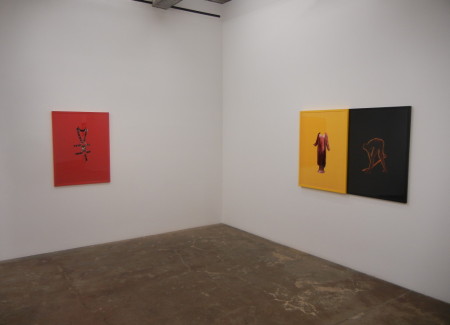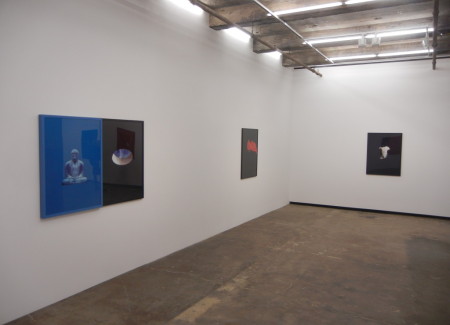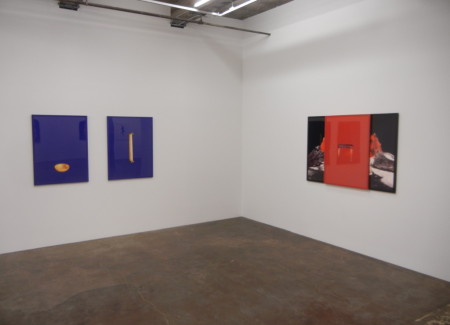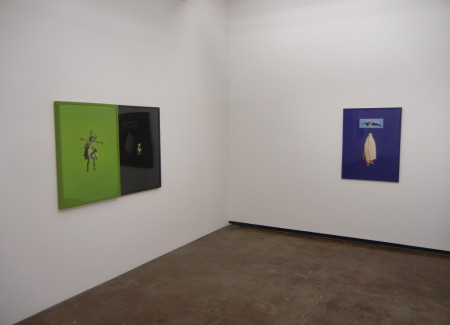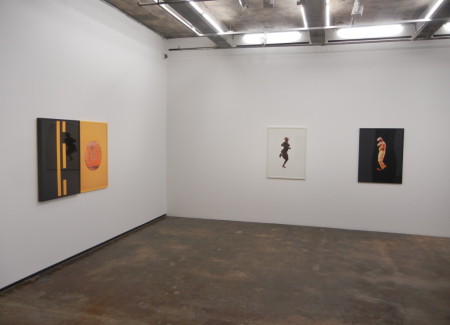JTF (just the facts): A total of 20 photographic works, framed in colored lacquered wood frames and unmatted, and hung against white walls in a series of three connected gallery spaces. All of the works are cibachrome prints, either single images or diptychs/triptychs, made between 1983 and 1988. The single panels are generally sized 32×42, while the diptychs/triptychs are sized 42×62, with one pair of panels at 32×32 each. Edition sizes are 3+2AP or 3+3AP for the single panels and 4+2AP for the diptychs and triptychs. (Installation shots below.)
Comments/Context: The act of appropriation, in its very purest form, is like pointing a spotlight – it focuses our attention on an image with such context-erasing ferocity that we suddenly see it with surprising and uncanny clarity. In our pluralistic remixed digital world, we’ve become jaded to the power of appropriation, mostly because borrowing and recontextualization are now so ubiquitous. But back in the mid 1980s when Sarah Charlesworth made the photographs in this superlative show, appropriation was like recently refined conceptual dynamite. She was scavenging images from books and magazines, transforming them through clever isolation and rephotography, and forcing us to see the seemingly ordinary with a new appreciation for hidden meanings and cultural connections, all while blasting our retinas with seductive wall-dominating color.
Charlesworth’s brand of appropriation was neither simple decontextualization (removing an image from its original context and making it stand on its own) nor overt recontextualization (removing an image from its original context and placing it in a new, often obviously conflicting context) – she was sneakier and more subtle than that. She deftly plucked various objects out of other media (pre Photoshop) and placed them against uniform monochrome backgrounds, and then in this series, added a simple symbolic context in the form of a color coding scheme, where red stands for sexuality, yellow for material desire, blue for metaphysical longing, green for nature, and black for the unknown. The effect is something like a mood enhancer or a typological architecture, where the rich, vibrant color gives the appropriated image something to play against, offering a nuanced pointer for how we might read the image that she has presented.
The reason these formal pairings of imagery and color are so successful is that they indirectly unpack invisible thoughts and powerful urges. Seen together, the pictures are a kind of catalog of desires (both male and female) and their manifestations in our visual language, from a sex harness (against eye popping red) to a sacrificial goat, and from a tumble of blond hair to a slinky white-suited David Bowie. Ancient dresses, ceremonial masks, ornate fertility figurines, and fancy furniture are at once objects and stand-ins for something more elemental, each one infused with palpable energy. There is a coolness to the Buddha bathed in blue, flanked by the mysterious oculus to the sky in the enveloping blackness – religion and the unknowable mixed into a heady brew. A glamorous disembodied gown is paired with body wrapped and tied in fetish garb, each an alluring anonymous figure for the right viewer, or perhaps opposite sides of the same coin. In Charlesworth’s hands, a sculpted wet t shirt, a ethereal red scarf, a geisha mask, a tiger, or even an erupting lava flow can become a tantalizing, multi-faceted intellectual provocation.
While many of us will have run across one or more examples from this series over the intervening years since they were produced, it’s quite another experience to see so many of them on view in one engrossing installation – seeing just one misses the larger context of Charlesworth systematically rationalizing desire, teasing out the many patterns in its visual language with glorious cerebral rigor. It will probably many more years before these artistic siblings are once again reunited, so don’t miss this rare chance to connect the dots and see elusive desire so smartly categorized.
Collector’s POV: The works on view in this show are on loan or generally not for sale; there were no prices available. Charlesworth’s work has less secondary market history than we might expect for a well known photographer of her generation. Public prices have generally ranged between $2000 and $12000, but this data only reflects a few lots changing hands in any given year in the past decade and therefore may not be entirely representative of the actual market for her best work.
